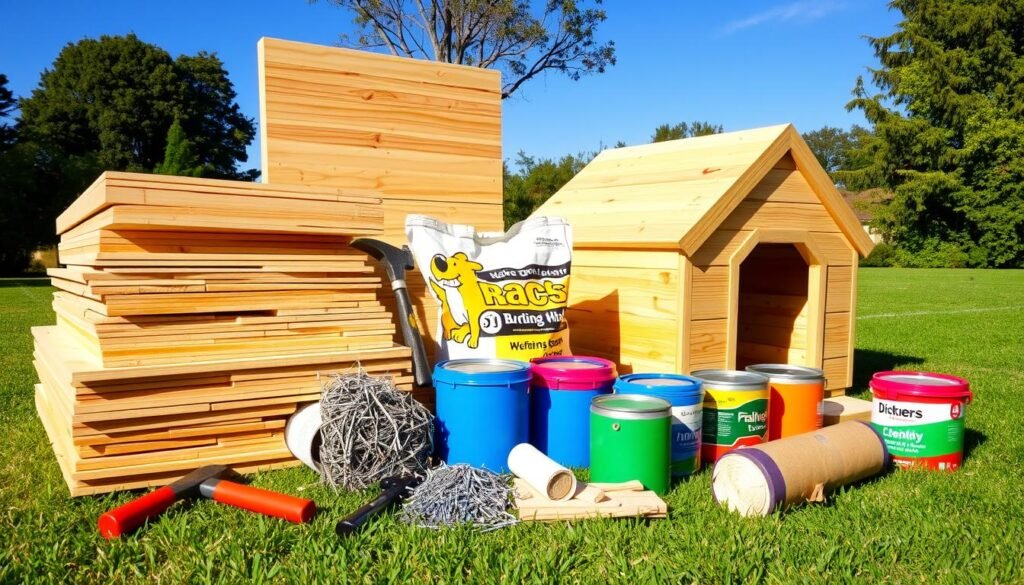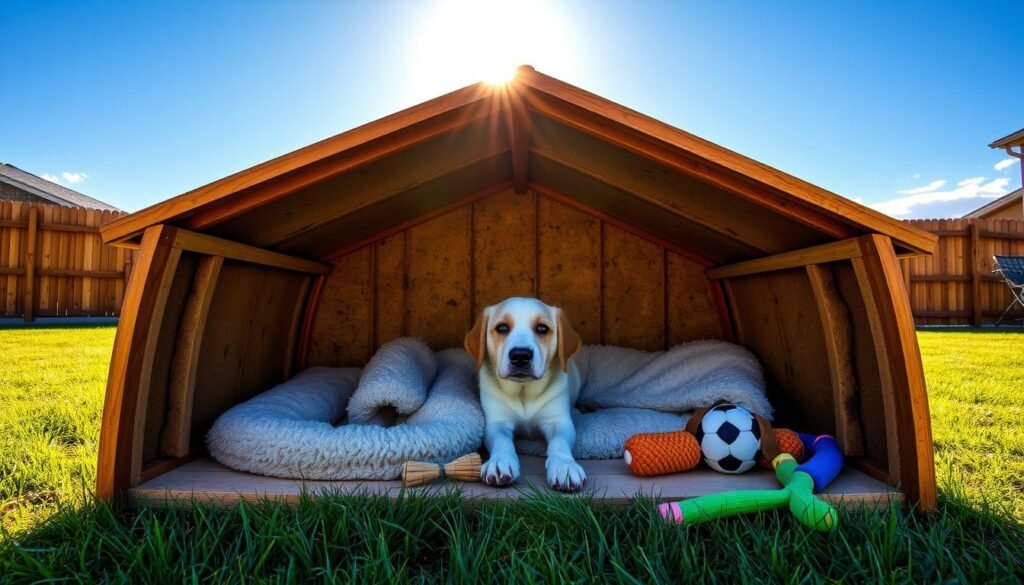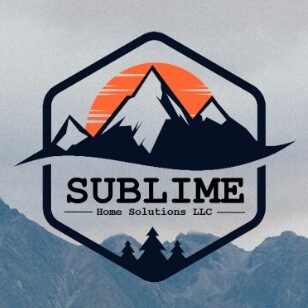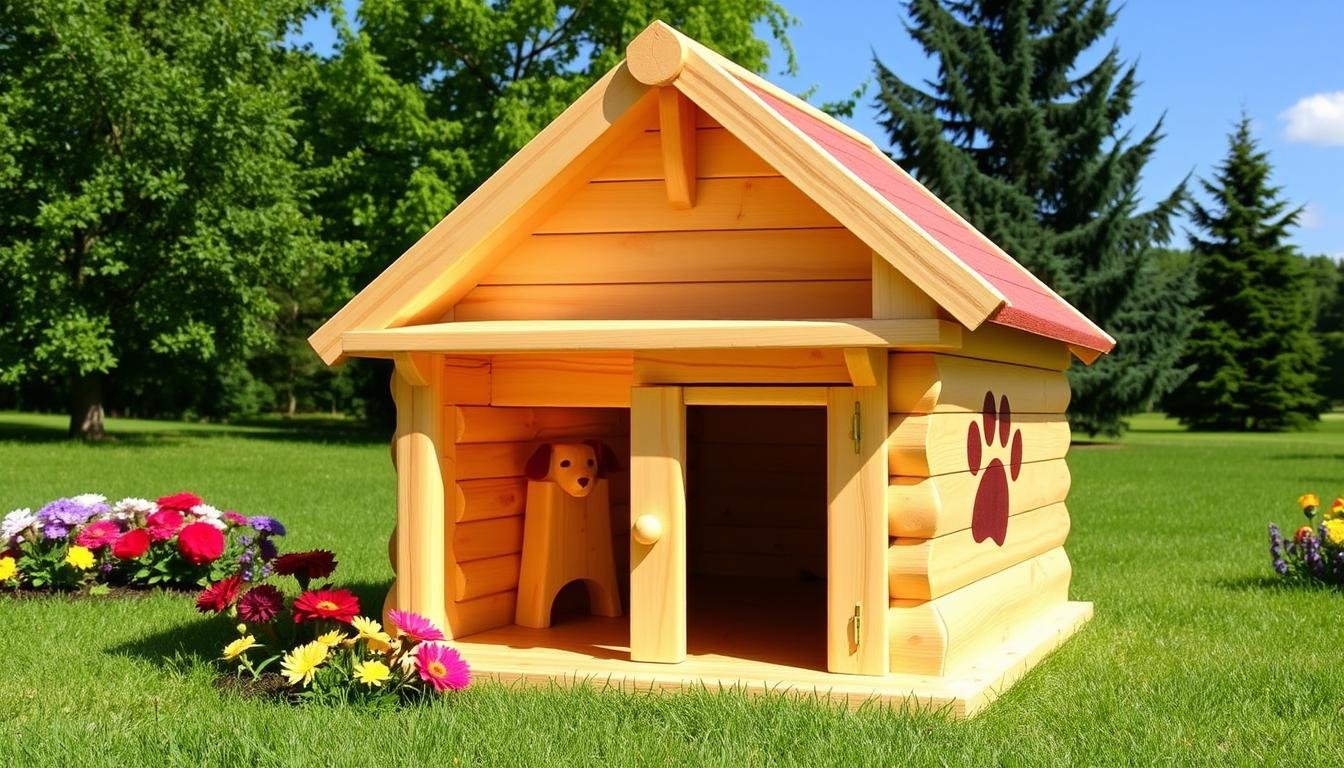Ever thought about how a good dog house can change your pet’s life? It’s not just about keeping them dry or warm. It’s about giving them a cozy place to call their own. Learn how to build a DIY dog house with our expert tips. See how Corey Hosick made a dream home for his German Shepherds, Lexi-Lou and Ranger-Roo.
Building a custom dog house is simpler than you might think. We’ll guide you through picking the right materials and making sure it’s safe and comfy. Let’s build the perfect shelter for your furry friend together.
Key Takeaways
- Two 4w9 I beams crossed with 3×5-in. and 2×2-in. square tubing were used for the frame.
- Four PT 4×4’s were used for the uprights.
- R-13 insulation was used for both floors and walls.
- The dog house features a 70-ft. 12/3 extension cord for exterior lighting.
- Providing enough room for your dog to stand and move is crucial.
- Consider outside temperature, dog size, coat, and other factors for outdoor time.
- Ensure proper insulation and ventilation for your doghouse.
Want more ideas to make your home pet-friendly? Check out these top home renovation tips for a fresh look without spending too much.
Choosing the Right Dog House Design
When picking the best dog house design for your pet, think about comfort and safety all year. It’s key to match the outdoor dog house to your local climate for your pet’s health.
Considerations for Climate
Climate is a big deal when picking a dog house. Wooden houses keep warm in cold weather. But, plastic houses can get too hot or cold.
Make sure the roof is 100% wood to block sunlight. Also, lift the dog house off the ground to keep it warm and flea-free. In rainy areas, slope the floor to keep water out.
Matching Your Home’s Aesthetic
Choosing a dog house matching home décor can make your backyard look better. Lap siding and cedar shingles are stylish and durable. Treated plywood makes the house last longer, even in bad weather.
Whether you choose a wooden or plastic dog house, like the Petmate Indigo, it should match your home. This makes your property look nicer.
Gathering the Necessary Materials
Building a dog house that lasts needs the right materials and safety in mind. You wouldn’t want your pet living in a bad place, right?
Best Wood for Outdoor Dog Houses
Cedar and pressure-treated plywood are top choices for wood. They fight off moisture and rot, keeping the dog house strong and dry.

Studies show cedar or pressure-treated wood are best because they resist the weather. Plus, insulation foam boards add warmth in cold months. That’s comfort all year round!
Safe Materials to Avoid
First, safety is key. Avoid old pressure-treated wood or plywood with harmful stuff like chromated copper arsenate. These can be dangers to your pet’s new home. You want a safe place for your dog.
Essential Tools for the Job
Building a dog house needs the right tools. Make sure you have:
- A saw (table saw or hand saw)
- Hammer
- Electric drill
- Paintbrush
But that’s just the start. You’ll also need 1.5-inch screws, 2-inch screws, and 1-inch nails. And don’t forget ½ inch tacks for roofing materials like 3-tab tiles.
| Tool | Use |
|---|---|
| Saw | Cutting wood to size |
| Hammer | Driving nails |
| Electric Drill | Creating holes for screws |
| Paintbrush | Applying paint or varnish |
So, get ready, pick the best materials, and keep safety in mind. Your pet will have a cozy, strong, and safe home!
Planning Your Dog House Construction
Before you start building your dog’s new home, a solid plan is crucial. Taking the right measurements and choosing a design is important. It saves time and ensures your dog’s comfort. Here, we’ll explain why measurements are key and share some simple dog house building plans.
Importance of Accurate Measurements
Building a DIY dog house requires precision. You don’t want a dog house that’s too small or too big. Make sure the size fits your dog perfectly. The height should be your dog’s height plus 9 inches. The length should be your dog’s length plus 18 inches. And the width should be your dog’s length plus 12 inches.
These measurements ensure your dog has enough space. They can stand, turn around, and lie down comfortably.
Simple Building Plans for Dog Houses
If you’re new to DIY dog house building, start with simple designs. These plans can be adjusted for your dog’s size:
- Base: Use pressure-treated lumber for durability and to protect against moisture.
- Walls: Build with plywood sheets and 1 ½-inch wide framing for strength.
- Insulation: Add a 3/4-inch layer at the bottom and use Titebond III for attachment.
- Roof: Use water-resistant roofing felt and shingles. Add a hinge for easy cleaning.
Also, think about adding some extra touches. Like a drip cap to keep water out or a decorative paw print. For more details, check out these dog house construction plans.
Being precise with measurements and keeping designs simple are key. Follow these tips, and your dog will be grateful!
Building a Great Dog House
Building a cozy home for your dog is easy, even if you’re not a carpenter. With a step-by-step dog house guide, you can make a stylish and functional dog house. This guide helps you build a dog house that keeps your pet warm or cool all year round. We’ll cover the key steps and why insulation is so important.
Step-by-Step Guide to Building
- Begin by cutting 2×4 wood boards into four pieces for the base. Use a framing square and pencil. For a medium-sized dog house, cut them to about 23 inches.
- Assemble these pieces into a rectangular base using 3” galvanized wood screws. This step is crucial for a solid foundation.
- For the sides and back frame, cut more pieces and connect them with 1-1/4” galvanized wood screws. Attach the floor panel securely to this frame.
- Build your walls and leave a 10-inch wide, 13-inch high opening for the entrance. This keeps the inside warm and cozy.
- Think about a triangular, sloping roof. It helps rain and snow slide off, keeping the inside dry.
- Secure roofing panels to the frame with galvanized screws. Then, cover them with asphalt-impregnated roofing paper for extra protection.
- Add a personal touch with paint or extra features like a nameplate and leash hooks.
Importance of Insulation
Insulation is key, especially in harsh weather. Start by insulating the floor with a layer beneath the plywood. Real wood walls add natural insulation, and the roof benefits too. The Insulated A-Frame Dog House from Instructables is a great, budget-friendly guide. 
Insulation keeps your dog’s house warm in winter and cool in summer. Do your research and choose quality materials. This way, your dog’s house will be a cozy home all year.
Incorporating Comfort Features
Creating the ultimate living space for your furry friend is key. Adding comfort features like proper ventilation and interior comfort is crucial. It’s not just about shelter; it’s about creating a cozy haven your dog will love.
Adding Ventilation and Windows
Good ventilation is essential for a balanced temperature in the dog house. Strategically placed windows allow for proper airflow. This keeps the structure cool in summer and warm in winter. Novack’s expert tip: the door’s position can create a protective area from direct environmental elements.
Maximizing Interior Comfort
Improving dog house interior comfort is more than just space. Add unique dog beds, fabric curtains, and dog-friendly furniture for a multifunctional room. A dog crate end table or hooks for hanging dog supplies can also transform the space. Plus, include entertainment options like toys, puzzles, and a Bluetooth speaker for soothing music.
| Comfort Feature | Incorporation Rate |
|---|---|
| Dog Beds and Curtains | High |
| Entertainment Options | Moderate |
| Functional Furniture | High |
| Interior Upgrades | Moderate |
Maintenance and Upkeep of the Dog House
Keeping your dog’s house clean and safe is easy with the right steps. A clean, safe, and comfy home for your pet is key. Here are some tips to keep your dog’s home in great shape.
Cleaning and Disinfection: A backyard dog house is vital for a clean outdoor spot. Regular cleaning fights fleas, ticks, and allergies. Use a mix of bleach and water to clean well. Sunlight also kills germs on bedding, reducing washing needs.
Cold-Proof Strategies: In cold areas, a hot water bottle or heating pad can warm up the dog house. Adding insulation to walls keeps your dog warm. Always check for leaks to keep the dog house in good shape.
Practical Upgrades and Components: Keeping the dog house safe and clean means regular updates. Features like a hinged roof or easy-to-clean parts help. Always ask vets for advice on what’s best for your dog’s size and breed.
| Component | Action | Frequency |
|---|---|---|
| Cleaning | Disinfect with bleach solution | Monthly |
| Bedding | Expose to sunlight | Weekly |
| Insulation | Check and upgrade | Annually |
| Roof & Parts | Inspect for damage | Biannually | Heating Elements | Replace as needed | Annually |
In short, regular care and modern comforts make your dog happy and healthy. Remember, regular checks and upkeep extend the dog house’s life. It stays a beloved spot for your pet.
Customizing Your Dog House
Personalizing your dog’s home is exciting and can make them happier. You can choose from a custom dog house or a modern one. Your furry friend deserves a stylish and useful space.
Think about your pet’s unique personality when customizing. A personalized dog shelter can be simple or detailed, like your own home. Did you know 60% of dog owners want insulated, air-conditioned, and heated dog houses? They want their pets to feel luxurious too!
If you like DIY, turning a shed into a dog house is a great idea. Here’s how:
- Get the right materials: You’ll need three sheets of 3/4” plywood.
- Attach the roof panels: Make them 3/4” longer for overlap.
- Shingle it up: Use 160 shingles, each cut into 9” lengths and resawn diagonally.
- Secure the ridge cap: Use 3.26 ounces of construction adhesive per piece.
- Consider the trim: Use 2×4 pine to create rabbets for the plywood edges.
Customization is key, but don’t forget about decor. 70% of dog owners add dog-themed decor. Why not add a cute front porch or non-toxic paint that matches your home?
Here’s a quick look at popular customizations:
| Feature | Benefits |
|---|---|
| Natural Light | Keeps the interior bright and welcoming. |
| Heating & Cooling | Maintains a comfortable temperature year-round. |
| Insulation | Essential for extreme climates. |
| Decorative Elements | Makes the dog house a true extension of the family home. |
Creating a personalized dog shelter is about mixing style with function. With some creativity, your dog will have the perfect home. It’s more than a shelter—it’s a home!
Ensuring Safety in Your Dog House Design
A good dog house keeps your pet safe and cozy. Safety is key when building one to protect both people and pets. Always wear gloves and eye protection to stay safe while building.
Inspecting for Hazards
Look for dangers like exposed nails, sharp edges, or splinters in the dog house. These can hurt your pet. So, it’s important to use strong, smooth materials.
Using Pet-Safe Finishes
Choose materials and finishes that are safe for pets, like untreated lumber and non-toxic paints. These prevent harm if your dog accidentally eats something. Make sure any adhesives or paints dry completely before letting your dog in.
By following these steps, you make your dog’s house safe and last longer. For more info on safe building, visit Sublime Home Solutions.
Benefits of an Elevated Dog House
Getting an elevated dog house is a smart move for your pet’s health. These houses are built high off the ground. They offer better weather protection, air flow, and upkeep, keeping your pet cozy and safe all year.
Weather Protection Advantages
Many dogs don’t like changing weather. Elevated dog houses shield them from extreme temperatures. In hot weather, they get a cooler spot to rest, avoiding fast breathing and heat strokes.
In cold months, an elevated house with insulation keeps your dog warm. This prevents hypothermia and other cold sicknesses.
Long-term Maintenance
The elevated design makes upkeep easier. It keeps moisture and bugs away, preventing rot and infestations. Plus, it’s simpler to clean and check the underside, keeping the house in great shape.
Following some key dog house maintenance tips makes upkeep a breeze. You can also add a personal touch with DIY woodworking plans. These plans can make your dog’s house stylish and functional.


